- Joined
- Mar 28, 2001
- Messages
- 6,341
Ok ... the results. Just took 4 more observations today to figure into the total so far making it 25 observations.
Out of 25 observers in total so far, 23 picked the GIA Ex in l.e.d. lighting and 23 picked the GIA Ex in daylighting, I kid you not!

I was thrown for a loop with this research!
What did I learn from this research? What conclusions are drawn? Quite a number of things.
1. GIA laid out the boundaries of their cut grade and are true to their reporting. They based it on observation testing and GIA does not have the market corned on this so I decided to perform my own. While the scandal that took place is an unfortunate mishap, to tie it to their cut grading research is a huge mistake. Their integrity, insofar as the grading is concerned is in tact with this Gman and the two instances should not be confused in the mind of the consumer. To slander their cut grading system based on an entirely different event is just plain wrong.
2. Reflector images, while good information to have are not reliable as an end all be all to cut grading. Here is a plain example where live evaluation and consumer preference sided with what reflector advocates would not suggest. The same could be said for any of the technologies. Does this discount reflector images or the other technologies entirely? In no way does it. It does however teach us what characteristics in reflector images to look for specifically to avoid diamonds that most consumers do not feel is the brighter, more fiery and scintillating diamond. I have said this in the past and I''ll say it again... reflector images (and the HCA) are not good for weeding out certain shallow combinations and in the instance of this study, neither is it good for weeding out certain steep/deep combos. Even AGS system allows for pavilion angles up to 41.2 which take a big hit on the HCA.
3. Here is an excellent example of two diamonds that fool the technologies but not the human eye. I am talking primarily about the painted stone but the other could apply as well. Before anyone miscontrues my words let me make this clear. The comparison was not that of a pretty diamond vs an ugly diamond. All of the observers agreed. The painted stone is by no means an ugly diamond but it does demonstrate precisely one excellent example of the why''s and how''s of GIA''s logic and science behind their cut grading system and why painted girdles do not make thier top grade. With this hard empiracle evidence I can only applaud it. They said up front it was based on observation testing, and my own independant results concur entirely at this point. To be honest and frank I had anticipated posting in this thread the exact opposite results and would have done so happily as I am an advocate of truth and integrity in business.
4. Remove the painted girdle from an H&A and you have a GIA Top Grade and rightfully so. Back in 2000-2001 I conducted a similar survey with 2 hearts and arrows diamonds. One with a painted girdle and one without (and this was before I ever heard of the word "painted girdle"). Crown/pavilion angles and table size virtually identical. Greater than 95% of our observers arrived at the same conclusions as this survey. My own personal preference sided with these observers as well and I had made known publicly on these forums what my own preference was and had dropped the painted girdle line for that reason (among others). During that time I had thought it was primarily due to lower half length and star length, however GIA has pinpointed the problem *precisely* with their research. Consumer opinion agrees no matter what any expert says.
5. Painted girdles fool technologies when observer preference runs counter, even in the case of a GIA Ex steep/deep!
I would now like to give my thoughts to Brian''s criticisms after our most current research into this matter. My response to each point will be in bold.
Let me begin by saying, I hold Brian in high regards and respect his opinions. Both of our companies have been participating on the diamond forums for the longest time and while we have our differences of opinion, at the end of the day I can still sit down with he and his lovely wife and staff and enjoy a laugh and a brew. John Quixote and I go back a long time too before he was ever in the trade (eh Cupid?) and last Vegas show just had a blast in the short time we spent with each other. I do not wish for you to take my comments personally guys and although I try hard to type with the right intentions, I realize it is easy to misconstrue words as well, especially over the net as you can’t look into my eyes and face as I write this. I realize it is natural within business’ to view the competition as “the enemy” sometimes, but let me say I write with no ill will at heart and have, as you, the best intentions for the common layman reading these boards. Do not take my criticisms personally is what I am saying. I think we can all learn by exploring the facts together and remaining open minded to the issues at hand.
Width of the Excellent grade: Using the current AGS system for comparison, GIA’s top grade is vast: A diamond graded GIA Excellent may be an AGS4 as easily as an AGS0. With GIA’s steep/deep allowances each lower AGS grade leads to extra weight within the same GIA grade. It is logical to presume that mass manufacturers will cut the heaviest possible GIA Excellent. Therefore, when a consumer is buying a GIA Excellent the statistical chance of him buying an AGS4 will be high. GIA may tell you that within their top grade there is no visible difference but AGS will tell you it can be divided into 5 different grades: It is impossible for both of these organizations to be correct. A vast top grade with abundant steep/deep combinations promotes sloppier cutting, which serves mass manufacturers, not the public.
> While it is true, the closer you get to the outskirts of the top grade from GIA, the spread will become less, they have however set a cap of 63% as the max depth allowable for their top cut grade. Considering the many manufacturers of ideal cuts (even ideal cut H&A’s), diamonds ranging from the 60.x range to the 62.x range I don’t see a cap of 63% as being unreasonable. In fact there are certain proportion combinations that are helped by making the stone slightly deeper. Another point of note … if we’re going to level criticism against GIA for this … how about AGS??? Are you aware of what their max depth allowable is? They allow for a spread of up to -5% and still be ideal. That means a diamond can have a total depth% of up to 62.8% and still be ideal. .2% off is nothing to wig out over.
Steep/deep cutting hides weight: As the pavilion is made steeper, weight is added and spread is reduced. Allowing EX to range up to a 41.8 pavilion adds approximately 4% to the bottom of the stone without improving spread. If manufacturers cut the steepest/deepest angles possible, stones with less spread and increased light leakage will proliferate.
> The simple question I have to ask here is “Have you ever seen what is being considered a GIA Ex Steep/Deep and compared it to stones that do not make the top cut grade?” Even more importantly have you showed this to consumers in a side by side comparison to let them decide? I have showed this comparison to consumers and the decision was virtually unanimous. Regardless of the angles the diamond is cut to, and no matter how hard factories attempt to hide weight, it still can not exceed the 63% mark.
Steep/deep cutting entraps body color: This situation will cause dichotomy in an already-imperfect color grading system. We all know that well-cut diamonds show less color face-up due to optimized light return. Now face up appearance will become more incongruent because steep/deep cutting entraps body color (fancy colored rounds are cut either very shallow or steep precisely because of this). At combinations near 41.8 / 34.0 the diamond appears darker and the color becomes more apparent in the face up position. Put a 41.8 angle on a J color and see how yellow it looks. An F may look like an H face up. This is the opposite of masking color with great cut. It is incongruent for these parameters to be graded ‘best’ in a system where colorless diamonds are considered most valuable.
> This begs the question, when have you physically *seen* a 34/41.8? And when you did see it did you show it to the average layman to see if they saw what you are claiming? I’m not saying the GIA system is without criticisms, what I am saying is if we are going to level these criticisms against GIA do it first with real live specimens. I was extremely skeptical as well until I physically got a GIA Ex Steep/Deep in my own hands, examined it in common lighting environments and also showed this to consumers to get their input as well. I don''t believe anyone should criticize something unless they have first hand experience with the item. Unless that is done we''re talking speculation. In the observation testing we’ve done so far with the GIA Ex, the diamond in question was a D color. I would agree that common steep/deeps entrap body color but the ones sorted out by observers, of lower colors I have not yet had a chance to see myself. If so, the point is conceded. My conviction is if we are going to criticize a diamond, let’s at least see it first before we jump to hasty conclusions.
Brillianteering is stereotyped: Certain brillianteering approaches are penalized en masse, even when they improve the look of the stone. This stereotyping is a mass-grading shortcut. Diamonds with premium configurations, optical symmetry and careful finish behave differently than those without. This stereotyping penalizes the art of skillful cutting: If GIA wants to downgrade a diamond because a girdle is inconsistent or wavy that is appropriate. But as long as the girdle is of reasonable thickness, is not wavy and is consistent it should be graded as Excellent. Specific configurations and optical symmetry change the playing field. If the effect on light performance is additive it should qualify for a top cut grade in any system, providing that the girdle is consistent.
>Both GIA observers (over 70k observations) and I, through the asking of consumers in our store through real life observation find the exact opposite of what you are claiming. GIA disqualifies girdle painting because it contributes to a darker appearance in common daylight environments. Virtually every consumer we show this to sees it as well. Back in 2000-2001 when I used to feature a painted girdle line in our store (back then I wasn’t even familiar with the term “painted”) we had performed our own observation experiment at that time by consumers all over the globe who had me send them for comparison, a diamond with the girdle cutting we’re talking about vs another diamond with similar slope angles that didn’t feature this characteristic. Over 95% of our observers consistently picked the same diamond (the one without the painted girdle) even when money was no issue. That observation was with 2 diamonds with similar or exact slope angles, and while there were differences in lower half and star length, the primary difference was the cutting of the girdle facets. Our most recent research was a similar comparison except with a GIA Ex steep/deep and the choice was still overwhelming in our observation testing.
Forced rounding: GIA reports altered measurements on their public grading reports. The current popularity of AGS documents and Sarin-type reports has developed a growing expectation among consumers for numbers reported to the tenth of a degree. GIA rounds numbers as much as 2.5 tenths and to nearest 5%. This is not accurate reporting.
> I don’t see this as an issue whatsoever and for good reason. Why? Because if I run a diamond on our Sarin (their top and most accurate model with the interchangeable lens) then send the diamond to AGS/GIA/RockDoc/Dave Atlas/Rich Sherwood etc. what do you think the chances are that the measurements will be exactly the same, especially down to a tenth of a degree? Slim to none would be the proper answer and you know this. Matter of fact when it comes to measuring lower half and star length, I find minor discrepancies between that and the Helium quite often if I’m going to look at tenths of a degree. Helium is perhaps the most accurate scanner in the world and when I compare Sarin’s to Helium’s, rounding lower half length within 2.5 tenths is not a big deal. Think about it … who on this planet would be able to detect, with their eyes, a diamond with 77.6% lower half length next to one with 80% length to see if they can see a difference? I would even challenge trade members to compare. Anyone who has the capabilities of measuring these facets and has the hardware to do it knows that nobody can see those differences in the face up appearance and that is what GIA’s primary concern was in their observation testing. Face up appearance. Until every manufacturer/retailer/appraiser gets a Helium then we can start leveling criticisms about the small rounding GIA is doing. If we are going to accuse GIA of inaccurate reporting then we must also do the same thing to everyone who offers a Sarin if it disagrees with the Helium and I think you would agree that is just not practical.
Rounding and brillianteering incongruities: The approaches are disproportionate. For example, all diamonds with 34.8, 34.9 and 35.0 CA are stereotyped as 35s, even though they do not behave as 35s. Those are vast angular differences. Meanwhile, brillianteering decisions at the girdle are fractional, measured in microns. These are distinct incongruities. To blindly round up angle measurements as much as a half degree in the crown and view them all as ‘the same’ for grading purposes, while blindly downgrading an individual diamond because of a difference of microns at the girdle is disproportionate and unscientific.
> It’s not unscientific when the average layman can not see these differences with his own eyes. Considering the inconsistencies of most non-contact scanners (Sarin/OGI) rounding a crown angle from 34.8 to 35, once again is no big deal. What person on this planet can, if we were to show them 2 diamonds with the same pavilion angles, lower halves, stars, girdles, and one diamond has a 34.8 degree crown angle next to one with an 35 degree crown angle, can tell the difference in the face up appearance? Answer: Nobody.
Girdle thickness: Girdle thickness ranges may have widened. This needs further examination to be confirmed. If this is true, it is another incongruity: GIA penalizes painting and digging, supposedly for ‘retaining weight’ in microns, yet may be allowing far more weight by thickening girdle ranges in a system that already favors steep/deep diamonds.
> Yet to be proven and once again, as far as retaining weight painting/digging can hide up to 3% in weight. Another good reason to disqualify them from top cut grades.
Facetware rounding issues: When using GIA’s online Facetware the forced rounding may result in a cut grade which varies, depending on user input. For a user who is unfamiliar with GIA’s lab strategies, this is tantamount to flipping a coin to decide the cut grade.
> It requires an understanding of the limitations of the Facetware program which GIA plainly lists on their site. For a person to understand the additional features that go into determining a cut grade it requires them to understand the issues of cut and the features that go into determining brightness, fire and scintillation. Once a person takes the time to learn it, it’s not an issue.
Symmetry never studied: Diamonds with premium symmetry behave differently than those without. The GIA planned to study symmetry deviations in 1998:
From G&G, Fall, 1998: "In addition, we plan to explore two important considerations that have been neglected thus far: symmetry and color. From our efforts and observations of actual diamonds for this study, we suspect that symmetry deviations may produce significant variation in brilliance (this was also suggested by A. Gilbertson, pers. comm., 199. Incorporation of symmetry deviations requires adding more parameters to describe the shape of the round brilliant, and devising a method of tracking multiple symmetry faults. Once this is done, the model can be used to calculate both images and metric values that show how symmetry deviations, both singly and in combination, change diamond appearance.”
If they had followed through, as other labs have, they would not be downgrading all diamonds based on brillianteering: Stereotyping en masse, without regard for the admitted difference symmetry brings, is a step backward and could be perceived as an insult to some of the world’s finest fashioners of diamonds.
> I emailed Al Gilbertson himself to find out the context of his quote. Al was speaking about, what was called at that time “radial symmetry”, a term coined by Kelsey McLeod who worked with Al during the days of DPL. That is the term which was later coined “optical symmetry” by Al and if we are to level accusations against GIA for not grading optical symmetry, then to be fair you must also offer the same criticism against AGS. The truth is, neither lab found optical symmetry detrimental to diamond appearance in the grand scheme of cut grading. This subject happens to be a peeve of my own and would have liked to see a grade for this as well but to stand back and point the finger at GIA alone for not doing it is moot if you’re not going to level the same accusations at AGS as well.
From GIA’s technical FAQ’s:
If a diamond looks better in one of the proprietary viewers (such as one of the “hearts and arrows” viewers), does it get a better grade in the GIA System? Did observation tests confirm that such diamonds look better?
Many people in the trade use the term “optical symmetry” in referring to “branded” diamonds that show near-perfect eight-fold symmetry by displaying eight “hearts” in the pavilion-up position, or eight “arrows” in the face-up position, when viewed in specially designed optical viewers. To investigate the possible benefits of optical symmetry, we included several such diamonds in our observation testing. We found that although many diamonds with optical symmetry received high observation scores, other diamonds (with very different proportions and, in many cases, no discernable optical symmetry) were ranked just as highly.
An interesting by-product of the testing was that those trade members who emphasized this type of diamond in their business generally chose such a diamond as the highest ranking (although not always). Those who did not market this type of diamond chose it as best about as often as they chose other diamonds we have placed in the top grade categories. It appears that these types of diamond could be likened to an “acquired taste” or “learned bias.” This doesn’t mean that some of them shouldn’t rank highly—it just means that not everyone agrees.
Finally, there are a variety of proportions that yield these patterns, some of which cause the diamond to appear darker to many observers. When a diamond had such a dark appearance, even though the pattern was considered a very good representation of a diamond with “optical symmetry,” many observers did not place it in the top category. This has been accounted for in our system.
Located at: http://www.gia.edu/research/29324/diamond_cut_faq.cfm]
Peace,





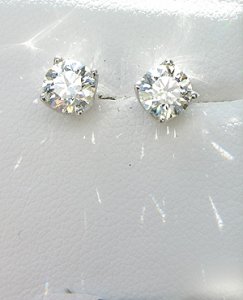
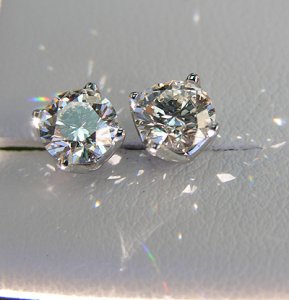
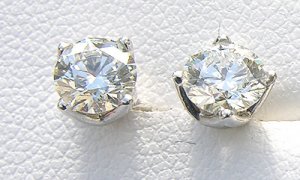
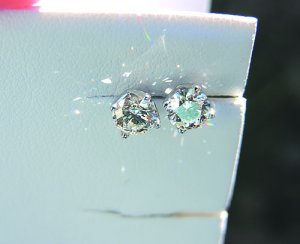

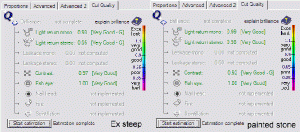


300x240.png)